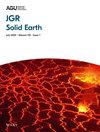Phases of Magmatism and Tectonics Along the Madagascar-Comoros Volcanic Chain, and Synchronous Changes in the Kinematics of the Lwandle and Somalia Plates
IF 3.9
2区 地球科学
Q1 GEOCHEMISTRY & GEOPHYSICS
引用次数: 0
Abstract
This paper aims to solve the longstanding debate on the origin of the Comoros volcanic archipelago (Mozambique Channel, Indian Ocean) concerning whether it represents a hotspot trail or a boundary between the Lwandle and Somalia plates in possible connection with the East African Rift System (EARS). To achieve this goal, we analyzed rock samples from recently discovered and previously uninvestigated volcanoes and edifices by means of geochemistry and geochronology. Major-trace element analyses and radiometric dating (40Ar/39Ar, K-Ar, and (U-Th)/He) allow us to identify a widespread phase of Comorian volcanism initiated at 9–8 Ma, involving the Zélée, Geyser, and Leven banks, three atolls east of the Comoros. Another tectono-magmatic phase initiated at 2.5 Ma led to a N-S widening of seamount volcanism, and to the progressive development of en-échelon NW-SE structures. With this new addition of atolls and seamounts, the Comoros Archipelago becomes a ∼700 km-long, ∼200 km-wide E-W chain extending from the Cenozoic volcanoes of Madagascar to the EARS. The reactivation of this chain at 9–8 and 2.5 Ma coincides with abrupt changes in the motion of the Somalia plate relative to the Lwandle plate, and with plate boundary modifications. The en-échelon reorganization of structures also matches the kinematic evolution of Somalia relative to Lwandle, from transtension (>3 Ma) to pure dextral slip (≤3 Ma) in the northern Mozambique Channel. We conclude that the Madagascar-Comoros volcanic chain is a branch of the EARS and a plate boundary, further strengthening the link between magmatism and the Rovuma-Lwandle-Somalia plate kinematics.马达加斯加-科摩罗火山链岩浆活动和构造的阶段,以及Lwandle和索马里板块运动的同步变化
本文旨在解决长期以来关于科摩罗火山群岛(莫桑比克海峡,印度洋)起源的争论,即它是否代表热点路径或Lwandle和索马里板块之间的边界,可能与东非裂谷系统(EARS)有关。为了实现这一目标,我们用地球化学和地质年代学的方法分析了最近发现的和以前未调查过的火山和建筑物的岩石样本。主要微量元素分析和放射性测年(40Ar/39Ar, K-Ar和(U-Th)/He)使我们确定了科摩罗火山活动的一个广泛阶段,始于9-8 Ma,涉及zsamelsame, Geyser和Leven银行,科摩罗东部的三个环礁。2.5 Ma开始的另一个构造岩浆期导致海山火山作用向北-南扩展,并导致en- samchelon NW-SE构造逐渐发育。随着新增加的环礁和海山,科摩罗群岛成为一条长~ 700公里,宽~ 200公里的东西向链,从马达加斯加的新生代火山延伸到EARS。该链在9-8和2.5 Ma的重新激活与索马里板块相对于Lwandle板块运动的突变和板块边界的修改一致。与Lwandle相比,索马里的整体结构重组也与索马里的运动演变相匹配,从莫桑比克海峡北部的拉伸(>3 Ma)到纯粹的右向滑动(≤3 Ma)。我们认为马达加斯加-科摩罗火山链是ear的一个分支和板块边界,进一步加强了岩浆活动与Rovuma-Lwandle-Somalia板块运动之间的联系。
本文章由计算机程序翻译,如有差异,请以英文原文为准。
求助全文
约1分钟内获得全文
求助全文
来源期刊

Journal of Geophysical Research: Solid Earth
Earth and Planetary Sciences-Geophysics
CiteScore
7.50
自引率
15.40%
发文量
559
期刊介绍:
The Journal of Geophysical Research: Solid Earth serves as the premier publication for the breadth of solid Earth geophysics including (in alphabetical order): electromagnetic methods; exploration geophysics; geodesy and gravity; geodynamics, rheology, and plate kinematics; geomagnetism and paleomagnetism; hydrogeophysics; Instruments, techniques, and models; solid Earth interactions with the cryosphere, atmosphere, oceans, and climate; marine geology and geophysics; natural and anthropogenic hazards; near surface geophysics; petrology, geochemistry, and mineralogy; planet Earth physics and chemistry; rock mechanics and deformation; seismology; tectonophysics; and volcanology.
JGR: Solid Earth has long distinguished itself as the venue for publication of Research Articles backed solidly by data and as well as presenting theoretical and numerical developments with broad applications. Research Articles published in JGR: Solid Earth have had long-term impacts in their fields.
JGR: Solid Earth provides a venue for special issues and special themes based on conferences, workshops, and community initiatives. JGR: Solid Earth also publishes Commentaries on research and emerging trends in the field; these are commissioned by the editors, and suggestion are welcome.
 求助内容:
求助内容: 应助结果提醒方式:
应助结果提醒方式:


